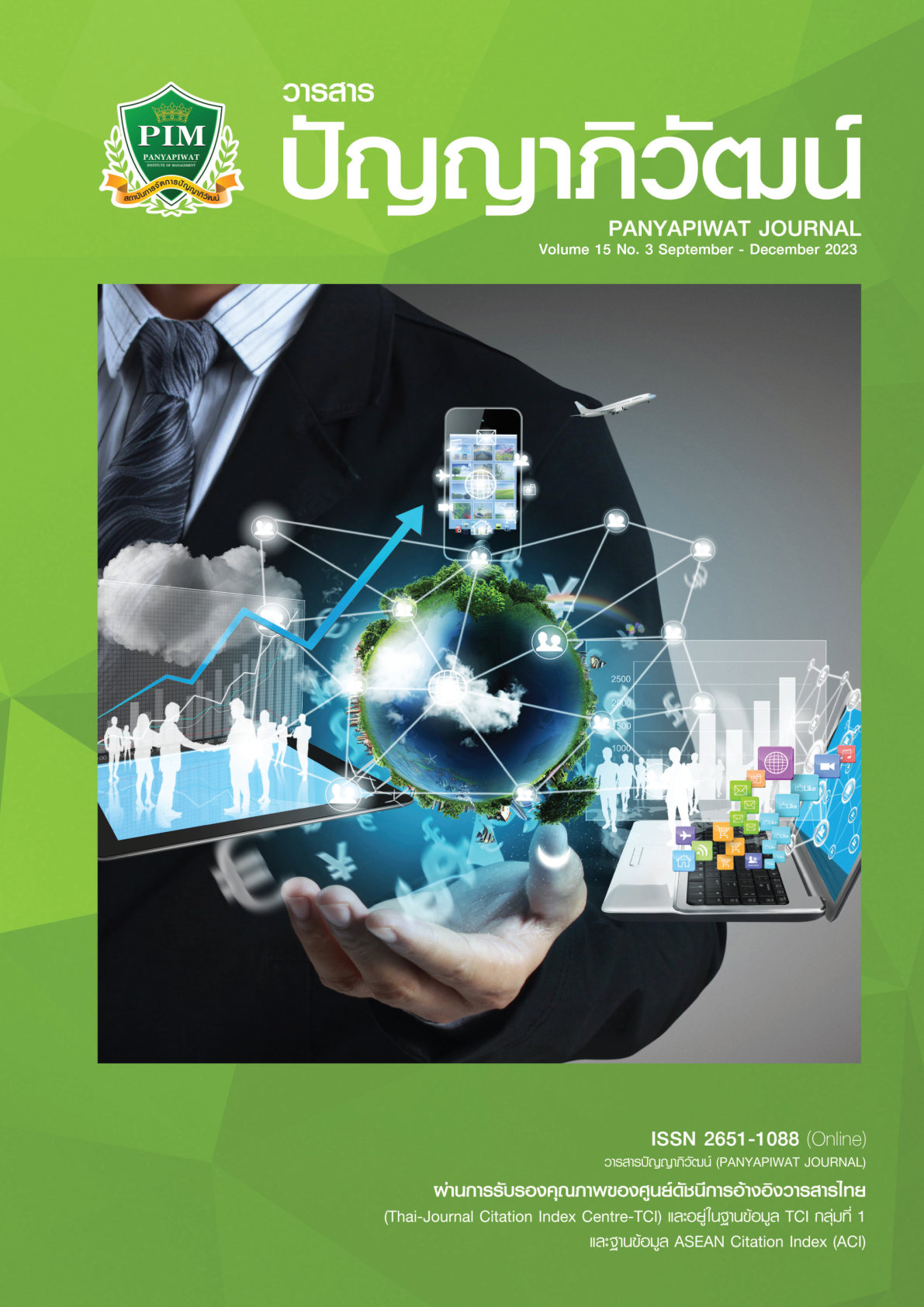รูปแบบการตลาดอิงการกุศล การสร้างคุณค่าทางการตลาด และการตัดสินใจซื้อ ผลิตภัณฑ์เพื่อสิ่งแวดล้อมในเขตภาคตะวันออกเฉียงเหนือตอนล่าง
Main Article Content
บทคัดย่อ
การวิจัย เรื่อง รูปแบบการตลาดอิงการกุศล การสร้างคุณค่าทางการตลาด และการตัดสินใจซื้อผลิตภัณฑ์เพื่อสิ่งแวดล้อมในเขตภาคตะวันออกเฉียงเหนือตอนล่าง เป็นงานวิจัยเชิงปริมาณ มีวัตถุประสงค์เพื่อ 1) ศึกษาระดับความคิดเห็นการตลาดอิงการกุศล การสร้างคุณค่าทางการตลาด และการตัดสินใจซื้อผลิตภัณฑ์เพื่อสิ่งแวดล้อม และ 2) ศึกษารูปแบบความสัมพันธ์ระหว่างการตลาดอิงการกุศล การสร้างคุณค่าทางการตลาดและการตัดสินใจซื้อผลิตภัณฑ์เพื่อสิ่งแวดล้อม ใช้สถิติวิเคราะห์โมเดลสมการโครงสร้าง (SEM-Structural Equation Modeling) จากขนาดกลุ่มตัวอย่าง 1,000 คน ในเขตภาคตะวันออกเฉียงเหนือตอนล่าง ได้แก่ จังหวัดนครราชสีมา จังหวัดบุรีรัมย์ จังหวัดสุรินทร์ จังหวัดศรีสะเกษ และจังหวัดอุบลราชธานี จากโปรแกรม AMOS ผลการวิจัยพบว่า 1) ผู้บริโภคมีความคิดเห็นการตลาดอิงการกุศลจากประเด็นปัญหาด้านทรัพยากรธรรมชาติมากที่สุด (X̄ = 4.17) ผู้บริโภคทราบถึงคุณภาพของผลิตภัณฑ์เพื่อสิ่งแวดล้อมโดยมีกระบวนการผลิตเป็นไปตามมาตรฐานมากที่สุด (X̄ = 4.13) และผู้บริโภคตัดสินใจจากคุณสมบัติหรือสรรพคุณตามที่กล่าวอ้างในการโฆษณา/บรรจุภัณฑ์ (X̄ = 4.11) 2) ผลการศึกษาความสัมพันธ์พบว่า การตลาดอิงการกุศลที่ดีให้กับผู้บริโภคนั้นจะมี ความสัมพันธ์กับการสร้างคุณค่าทางการตลาด โดยการตลาดอิงการกุศลนั้นสามารถอธิบายการสร้างคุณค่าทางการตลาดได้ร้อยละ 90.1 และการสร้างคุณค่าทางการตลาดนั้นมีความสัมพันธ์กับการตัดสินใจซื้อและสามารถอธิบายการสร้างคุณค่าทางการตลาดได้ร้อยละ 99.0 สามารถนำไปกำหนดกลยุทธ์การตลาดอิงการกุศล โดยใสใจ ด้านคุณภาพและส่งผลทำให้ผู้บริโภคมีพฤติกรรมการตั้งใจในการซื้อสินค้าต่อไป
Article Details

อนุญาตภายใต้เงื่อนไข Creative Commons Attribution-NonCommercial-NoDerivatives 4.0 International License.
“ข้าพเจ้าและผู้เขียนร่วม (ถ้ามี) ขอรับรองว่า บทความที่เสนอมานี้ยังไม่เคยได้รับการตีพิมพ์และไม่ได้อยู่ระหว่างกระบวนการพิจารณาลงตีพิมพ์ในวารสารหรือแหล่งเผยแพร่อื่นใด ข้าพเจ้าและผู้เขียนร่วมยอมรับหลักเกณฑ์การพิจารณาต้นฉบับ ทั้งยินยอมให้กองบรรณาธิการมีสิทธิ์พิจารณาและตรวจแก้ต้นฉบับได้ตามที่เห็นสมควร พร้อมนี้ขอมอบลิขสิทธิ์บทความที่ได้รับการตีพิมพ์ให้แก่สถาบันการจัดการปัญญาภิวัฒน์หากมีการฟ้องร้องเรื่องการละเมิดลิขสิทธิ์เกี่ยวกับภาพ กราฟ ข้อความส่วนใดส่วนหนึ่งและ/หรือข้อคิดเห็นที่ปรากฏในบทความข้าพเจ้าและผู้เขียนร่วมยินยอมรับผิดชอบแต่เพียงฝ่ายเดียว”
เอกสารอ้างอิง
Arslanagic-Kalajdzic, M., Kadic-Maglajlic, S., Dlacic, J., & Zabkar, V. (2022). We go together: Under-standing social cause-related purchase intentions of young adults. Journal of Business Research, 140, 130-142.
Badenes-Rocha, A., Bigne, E., & Ruiz, C. (2022). Impact of cause-related marketing on consumer advocacy and cause participation: A causal model based on self-reports and eye-tracking measures. Psychology & Marketing, 39(1), 214-226.
Baker, J., Parasuraman, A., Grewal, D., & Voss, G. B. (2002). The influence of multiple store environment cues on perceived merchandise value and patronage intentions. Journal of Marketing, 66(2), 120-141.
Bhatti, H. Y., Galan-Ladero, M. M., & Galera-Casquet, C. (2023). Cause-related marketing: A systematic review of the literature. International Review on Public and Nonprofit Marketing, 20(1), 25-64.
Chuenyen, B. (2019). A study of consumer perceptions and factors affecting decisions to buy consumer goods designed for the environment in the region in the lower Northeastern region (South Isaan). Journal of Srivanalai Vijai, 10(1), 121-135. [in Thai]
Cronbach, L. J. (1990). Essentials of psychology testing (5th ed.). Harper Collins.
Department of Provincial Administration, Ministry of Interior. (2021, December 31). Announcement of the Department of Provincial Administration on notification of administrative information. https://www.dopa.go.th/news/cate1/view6988 [in Thai]
Diamantopoulos, A., & Siguaw, A. D. (2000). Introducing LISREL: A guide for the uninitiated. Sage Publications.
Ellen, P. S., Webb, D. J., & Mohr, L. A. (2006). Building corporate associations: Consumer attributions for corporate socially responsible programs. Journal of the Academy of Marketing Science, 34(2), 147-157. [in Thai]
Gurbuz, I. B., Nesirov, E., & Ozkan, G. (2021). Investigating environmental awareness of citizens of Azerbaijan: A survey on ecological footprint. Environment, Development and Sustainability, 21(1), 10378-10396.
Hamilton, R., Ferraro, R., Haws, K. L., & Mukhopadhyay, A. (2021). Traveling with companions: The social customer journey. Journal of Marketing, 85(1), 68-92.
Kasikorn Bank. (2022, October 12). Sustainability development report. https://www.kasikornbank. com/th/sustainabledevelopment/SDAnnualReports/SD_TH_KBank56.pdf [in Thai]
Kotler, P., & Lee, N. (2005). Corporate social responsibility. John Wiley & Sons.
Krause, D. (1993). Environmental consciousness: An empirical study. Environment and Behavior, 25(1), 126-142.
Nuntasomboon, K. (2022). The development of environmental education sustainable participation of Lamphun Subdistrict, Muang District, Kalasin Province [Doctor dissertation]. Mahasarakham University. [in Thai]
Olsen, G. D., Pracejus, J. W., & Brown, N. R. (2003). When profit equals price: Consumer confusion about donation amounts in cause-related marketing. Journal of Public Policy and Marketing, 22(2), 170-180.
Phonsrilert, P. (2009). (2021, September 13). Social responsibility and social marketing in Thailand. http://phongzahrun.wordpress.com/2012/01/06 [in Thai]
Pinyo-anuntapong, B. (1993). Concept and methods. Faculty Computational Science, Srinakharinwirot University. [in Thai]
Pollution Control Department. (2019). Summary of pollution situation in Thailand in 2019. Mongkhon Printing. [in Thai]
Prasitrattasin, S. (2012). Research methodology in social sciences. Chulalongkorn University Press. [in Thai]
Sun, Y. N. (2016). Perceived value affecting consumers’ purchasing intention of organic fruits and vegetables in Bangkok [Master’ thesis]. Bangkok University. [in Thai]
Sweeney, J. C., & Soutar, G. N. (2001). Consumer perceived value: The development of a multiple item scale. Journal of Retailing, 77(2), 203-220.
Wanitbhancha, K. (2014). Use of SPSS for windows in data analysis (14th ed.). Samlada Printing House. [in Thai]
Wituranich, H. (2020). The Influence of perceived value on consumer satisfaction and engagement via Facebook fan page of fashion brands [Master’ thesis]. Bangkok University. [in Thai]


